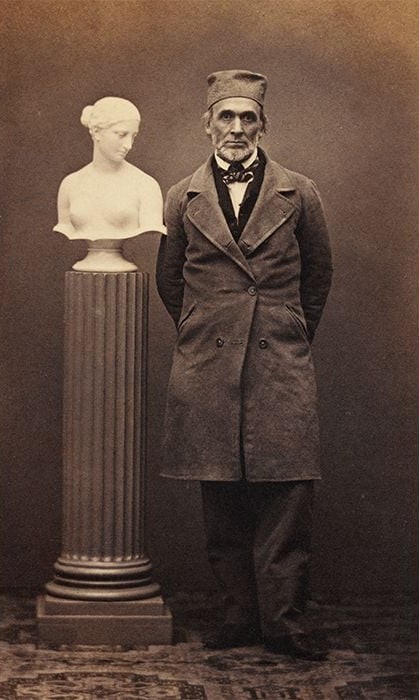First Exhibitions of Hiram Powers's "Greek Slave"
Created by Emily Crider on Mon, 04/14/2025 - 09:45
Part of Group:

In 1843, American sculptor and artist Hiram Powers completed the first rendition of his statue, the Greek Slave. Initially created as a representation of Turkish atrocities committed during the Greek War of Independence (1821-1829), the statue "became one of the most popular, frequently replicated, and widely exhibited works of art in America and Europe" within a decade of its creation (Stone and Taylor, WEBB vol. 2). This was in part due to the statue's appearance in various prominent galleries in London and across the eastern United States during a six-year-long exhibitionary tour managed by Powers's good friend and fellow artist Miner Kellogg. The Greek Slave was met with mixed, though mostly positive reviews, and commentary and transformative interpretations regarding the racial politics of Powers's work was, understandably, most prominent on the American leg of its trip. In May 1848, the statue was removed from its Philadelphia exhibit by James Robb, a wealthy New Orleans banker and art collector who had laid claim to the statue following a disagreement with Powers over the statue's rightful ownership. Powers then sent a replacement on the exhibitionary tour, resulting in the display of two models of the Greek Slave being displayed in different American galleries at the same time.
In addition to the major stops on the tour (listed below in chronological order), the map includes both the studio in Florence where Powers sculpted the original Greek Slave and Casa Guidi, the home of Elizabeth Barrett Browning, whose sonnet "Hiram Powers' Greek Slave" (1850) was inspired by an 1847 visit to Powers's studio.
Exhibition Timeline:
1. May – December 1845: exhibited in London
2. 26 August – 23 December 1847: exhibited in New York
• December 1847: Hiram Powers fights with James Robb, a New Orleans banker and art collector,
over ownership of the statue currently on exhibit
3. 25 January – 25 March 1848: exhibited in Washington, D.C.
4. April 1848: exhibited in Baltimore
5. May 1848: exhibited in Philadelphia
• May 1848: statue seized by Robb
6. August 1848: Powers's substitute statue is exhibited in Boston
7. 26 October 1848 – 3 January 1849: substitute statue exhibited in Cincinatti
8. 23 November 1848 – March 1849: the original statue exhibited at Robb's gallery in New Orleans
9. January1849: substitute statue exhibited in Louisville
10. February – May 1849: substitute statue exhibited in New Orleans
• Early 1849: Robb sells his Greek Slave for $3,000 to settle personal debts
11. July – August 1849: statue exhibited in Boston for the second time
12. September – 12 December 1849: statue exhibited in New York for the second time
13. 1 May – 15 October 1851: Greek Slave was featured at the Crystal Palace during the Great Exhibition of 1851
Note: for more information, please see Richard P. Wunder's thorough and comprehensive book Hiram Powers: Vermont Sculptor, 1805-1873, vol. I.
Image Source: Hiram Powers and a Bust of the Greek Slave, 1850s, (Smithsonian). EBB's "Hiram Powers' Greek Slave" was written about a full-sized version of the statue.

